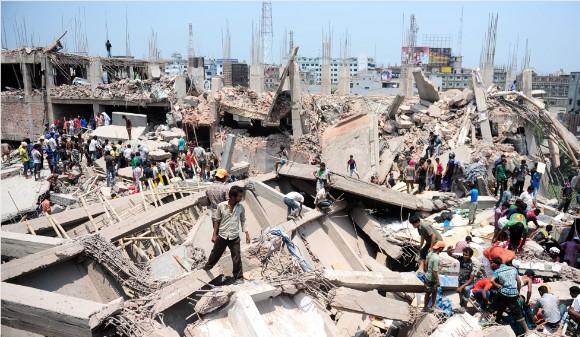by Dianne Feeley
March 8, 2014
International Women’s Day was originally conceived as International Working Women’s Day and organized in part by the Second International. This piece was written for the holiday and to honor that tradition of fighting for working women’s rights.
Next month will be the first anniversary of the Rana Plaza building collapse in Bangladesh, which resulted in the deaths of 1,160 garment workers, mostly young women. Although the disaster occurred on April 24, 2013, two hundred workers are still missing. This is the largest disaster in the history of the international garment industry.

The collapsed building in Bangladesh.
Workers throughout the eight-story building had been sent home early the day before so that an engineer could conduct a thorough inspection; he found cracks throughout and declared the building “unsafe.” The bank and shops on the lower levels remained closed but the garment factories on the upper four floors, constructed without permits, sent factory bosses around to the areas where their workers lived, demanding that they reported to work. Knowing they would have their pay check blocked if they stayed home, they reported. As soon as the power generators were turned on, the building collapsed. Some workers remained trapped for days until officials or relatives were able to pull them out.
The year before, illegally-stored materials caught fire at Tazreen Fashions. Employees were ordered to ignore the fire and continue working until smoke enveloped the eight-story structure, including its staircase. Many of the windows had iron grilles that prevented workers from escaping. Out of a work force of 1,150, 112 died.
These two industrial disasters are the result of conditions imposed by a global supply chain that has subcontractors in the poorest countries making apparel worn in Europe, Canada, and the United States. Worldwide the garment industry sells $48 billion worth of clothes, with China and Bangladesh as the #1 and #2 exporters. In Bangladesh, 500 garment factories produce over $20 billion worth of apparel for export, for U.S. based companies including Walmart, Sears, Gap, and Children’s World. Most factories are around Dhaka, the capital, and employ 3.5 million. Eighty percent are young women, often coming to the city from agricultural areas.
Bangladesh has the lowest wages in the garment industry: $37 a month is the minimum. Facing dangerous working conditions and abuse from their bosses, the women work 12-14 hours a day, 7 days a week as long as there is a contract. Labor organizing faces hostility from the owners, who have enough influence with various government agencies that they can obtain permits and build with substandard materials and have influence with the police.

Aminul Islam.
In 2010 Aminul Islam, a former textile worker, along with two other labor organizers, was arrested, tortured, and indicted for causing a riot. In 2012 he was tortured, killed, and left by the side of the road, near a police station. No arrest has been made.
The Bangladesh disasters parallel those that occurred in the U.S. garment industry over a hundred years ago. On March 25, 1911 a fire broke out at the viciously anti-union Triangle Shirtwaist Factory, located on the 7th, 8th, and 9th floors of the Asche Building, near New York City’s Washington Square. The company had beaten a strike in 1910-1 so that the strikers’ demands were never implemented: unlocked doors on the factory floors, working fire escapes, and a 54-hour work week.
The fire spread quickly and 146 women, children and men died. Some attempted to jump into blankets or fire nets below, but the force of their fall left them smashed on the street or cellar below. Five days following the fire, two of the Triangle owners had set up shop, and inspectors found machines blocking worker access to fire escapes.
Protest meetings, memorial meetings, and a massive funeral parade of at least 120,000 marched in tribute to the dead, led by the garment workers’ banner: “We demand fire protection.” Factory safety laws, union organizing in the garment sector and support from the Women’s Trade Union League were spurred on by the horror of those deaths.
Currently organizations, from United Students Against Sweatshops (USAS) to the European-based Clean Clothes Campaign, expose the conditions of the global supply chain, ferret out the brands that are made under these horrendous conditions and demand their accountability. In Bangladesh women workers are fearful that the Western-based companies will cut and run but it is clear that the campaigns are designed to improve working conditions and raise wages, not allow companies to find other suppliers in other countries. From the rubble and ashes of these disasters must come demands that allow workers, particularly women workers, the capacity to fight for a better life.
Dianne Feeley is a retired autoworker in Detroit, and a member of Solidarity’s National Committee.
